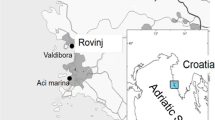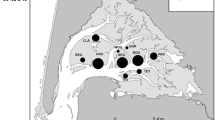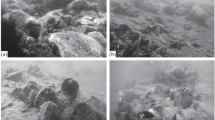Abstract
The life history of the bivalve-inhabiting hydroid Eugymnanthea inquilina was investigated in two different hosts, the mussel Mytilus galloprovincialis (collected from 1989–1991 from the Ionian Sea, Italy) and the clam Ruditapes decussatus (collected from 1991–1992, Ionian Sea, Italy). Hydroids living in mussels revealed a size selection for hosts longer than 40 mm, being almost completely absent in mussels below this size. This might be controlled by signals linked to the sexual maturity of the bivalve. The proportion of molluscs inhabited showed a seasonal trend in mussels only, with a sharp decline at the onset of medusoid liberation. Production of medusoids was high in mussels, whereas medusoids were rare and often abortive in clams. This indicates a higher degree of fitness of E. inquilina in mussels than in clams. The hydroid life cycle was not completed in clams, which therefore were presumably supplied by planulae from medusoids produced by mussel-inhabiting hydroids. Mussels played a key role in the stability and persistence of E. inquilina populations in the studied area. Selective ingestion of trematode sporocysts by E. inquilina hydroids indicated a protective role of the hydroid against mussel parasites, leading to reconsideration of this symbiotic association as a possible mutualism rather than a simple inquilinism.
Similar content being viewed by others
References
Boero, F. (1984) The ecology of marine hydroids and effects of environmental factors: a review. Pubbl. Staz. zool. Napoli (I: Mar. Ecol.) 5 (2): 93–118
Boero, F., Bouillon, J., Piraino, S. (1992). On the origins and evolution of hydromedusan life cycles. In: Dallai, R. (ed.) Sex origins and evolution. Selected symposia and monographs U.Z.I. 6. Mucchi, Modena, p. 59–68
Boucher, D. H., James, S., Keeler, K. H. (1982). The ecology of mutualism. A. Rev. Ecol. Syst. 13: 315–347
Bouillon, J. (1985). Essai de classification des Hydropolypes-Hydroméduses (Hydrozoa-Cnidaria). Indo-Malayan Zool. 1: 29–243
Brinckmann Voss, A. (1973). The life cycle of Eirene lactea (Mayer 1900) and Helgicirrha schulzei (Hartlaub 1909). Publs Seto. mar. biol. Lab. 20: 63–72
Cardellicchio, N., Marra, C., Ragone, P., Annichiarico, C., Leone, G. (1993). Caratterizzazione chimico-fisica delle acque dei bacini tarantini Rapp. Tecn. 37/93, Istituto Talassografico CNR Taranto, Taranto
Cerruti, A. (1941). Mytilhydra polimantii n. gen., n.sp., idroide vivente sul mantello dei mitili. Riv. Biol. 32: 1–18
Cheng, T. C. (1967). Marine molluscs as hosts for symbiosis with a review of known parasites of commercially important species. Adv. mar. Biol. 5: 1–424
Crowell, S. (1957). Eugymnanthea, a commensal hydroid living in pelecypods. Pubbl. Staz. zool. Napoli 30: 162–167
Cushman, G. H., Beattie, A. J. (1991). Mutualism: assessing the benefits to hosts and visitors. Trends Ecol. Evol. 6 (6): 193–195
Jørgensen, C. B. (1966). Biology of suspension feeding. Pergamon Press, New York
Kubota, S. (1979). Occurrence of a commensal hydroid Eugymnanthea inquilina from Japan. J. Fac. Sci. Hokkaido Univ. 6 (21): 396–406
Kubota, S. (1983). Studies on life history and systematics of the Japanese commensal hydroids living in bivalves, with some reference to their evolution. J. Fac. Sci. Hokkaido Univ. 23 (4): 296–402
Kubota, S. (1985). Systematic study on a bivalve-inhabiting hydroid Eugymnanthea inquilina japonica Kubota from central Japan. J. Fac. Sci. Hokkaido Univ. 24(2): 70–85
Kubota, S. (1987). Occurrence of a bivalve-inhabiting hydroid Eugymnanthea inquilina japonica Kubota. Galaxea 6: 31–34
Kubota, S. (1989). Systematic study of a paedomorphic derivative hydrozoan Eugymnanthea (Thecata-Leptomedusae). Zool. Sci. 6: 147–154
Kubota, S. (1991). The stability of diagnostic characters of the medusa of a bivalve-inhabiting hydrozoan Eugymnanthea japonica Kubota in Japan. Proc. Jap. Soc. syst. Zool. 44: 1–7
Kubota, S. (1992). Four bivalve-inhabiting hydrozoans in Japan differing in range and host preference. In: Bouillon, J., Boero, F., Cicogna, F., Gili, J. M., Hughes, R. G. (eds) Aspects of hydrozoan biology. Sci. Mar., Barcelona, p. 149–159
Kubota, S. (1993). Multiple colonization and sex ratio of a bivalveinhabiting hydroid Eugymnanthea japonica (Leptomedusae, Eirenidae) in three host bivalve species in Japan. Publs Seto mar. biol. Lab. 36 (3) (in press).
Labura, Z., Hrs.-Brenko, M. (1990). Note on the incidence of the hydroid Eugymnanthea inquilina Palombi in mussels Mytilus galloprovincialis Lamarck along the eastern Adriatic coast. Rapp. P.-v. Cons. int. expl. Mer Méditerr. 32 (1): 29
Millard, N. A. H. (1975). Monograph on the Hydroida of Southern Africa. Ann. S. Afr. Mus. 68: 1–513
Palombi, A. (1935). Eugymnanthea inquilina nuova leptomedusa derivante da un atecato idroide ospite interno di Tapes decussatus L. Pubbl. Staz. zool. Napoli 15: 159–168
Piraino, S., Bouillon, J., Boero, F. (1992). Halocoryne epizoica (Cnidaria, Hydrozoa) a hydroid that bites. In: Bouillon, J., Boero, F., Cicogna, F., Gili, J. M., Hughes, R. G., (eds) Aspects of hydrozoan biology. Sci. Mar., Barcelona, p. 141–147
Rees, W. J. (1967). A brief survey of the symbiotic associations of Cnidaria with Mollusca. Proc. malac. Soc. Lond. 37: 213–231
Renzoni, A. (1973). Dati di accrescimento e ciclo riproduttivo di Mytilus galloprovincialis Lamk. nella Sacca di Scardovari. Boll. Pesca Piscic. Idrobiol. 28 (2): 205–216
Rohde, K. (1982). The ecology of marine parasites. University of Queensland Press, St. Lucia
Tiscar, P. G. (1992). Patologie infettive ed infestive dei molluschi eduli lamellibranchi allevati o raccolti nei litorali pugliesi. Ph.D. Thesis, IV Ciclo, Università di Bari, Bari
Tursi, A., Matarrese, A., Scalera-Liaci, L., Cecere, E., Montanaro, C., Chieppa, M. (1985). Struttura della popolazione di Mytilus galloprovincialis (Lam.) presente nei banchi naturali del Mar Piccolo di Taranto. Quad. Lab. Tecnol. Pesca Ancona 4 (2): 183–203
Uchida, T. (1964). Medusae of Eugymnanthea, an epizoic hydroid. Publs Seto mar. biol. Lab. 12: 101–107
Author information
Authors and Affiliations
Additional information
Communicated by M. Sarà, Genova
Rights and permissions
About this article
Cite this article
Piraino, S., Todaro, C., Geraci, S. et al. Ecology of the bivalve-inhabiting hydroid Eugymnanthea inquilina in the coastal sounds of Taranto (Ionian Sea, SE Italy). Marine Biology 118, 695–703 (1994). https://doi.org/10.1007/BF00347518
Received:
Accepted:
Issue Date:
DOI: https://doi.org/10.1007/BF00347518




